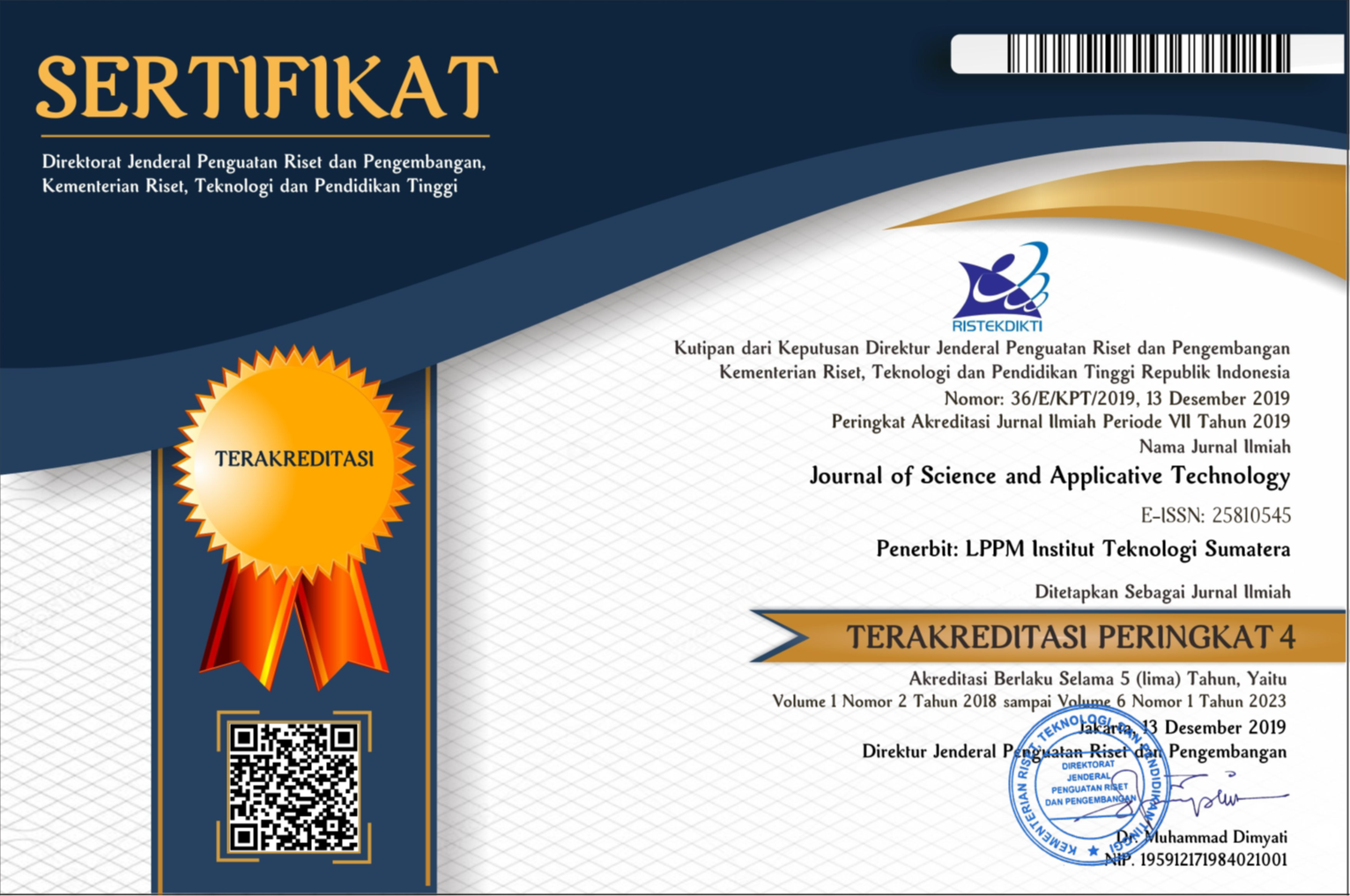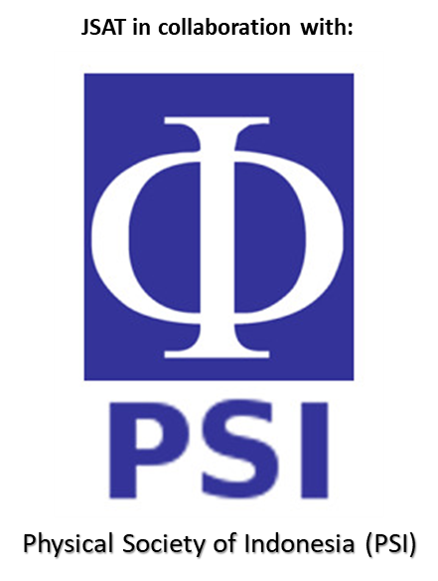STUDI KOMPARASI UNTUK AS-BUILT SURVEY DAN PENGAWASAN DEFORMASI DARI GEDUNG: METODE TERESTRIS VS METODE SATELIT DI GEDUNG KULIAH UMUM (GKU) INSTITUT TEKNOLOGI SUMATERA
Abstract
Infrastructure development is one of the main points of the program by the Indonesian government, outlined in Nawacita. One of the manifestations of this program in 2019 was the construction of the Gedung Kuliah Umum (GKU) at the Institut Teknologi Sumatera (Itera). As an effort to realize sustainable development, Geodetic surveys named 'as-built surveys' and periodic deformation observations need to be conducted. Both surveys can be done by terrestrial method using total station and satellite method using GPS-RTK. In this article, an analysis of the accuracy, precision and efficiency of the terrestrial method and satellite method for as-built survey and deformation observation at GKU Itera is reported along with a comparison between deformation calculation and direct observation. It was found that the terrestrial method produced better accuracy and precision level (19,5 cm compared to 43,3 cm) than the satellite method with 95% confidence level. In addition, the terrestrial method produces 3 times more data than the satellite method, although on the other hand, the total observation time of the terrestrial method is 100% longer than the satellite method. These results show that periodic monitoring is important for detecting the degree of deformation and realizing sustainable development. In addition, the terrestrial method is more suitable for accurate and precise periodic surveillance of a building than the satellite method. These findings could act as a contribution towards better sustainable deformation monitiring of a building and to underline the importance of having such periodic observations.
Downloads
References
[2] A. O'Sullivan and S. M. Sheffrin, Economics: Principles in Action, New Jersey: Pearson Prentice Hall, 2003.
[3] Kementerian Komunikasi dan Informatika, [Online]. Available: https://web.kominfo.go.id/sites/default/files/KSP%202%20Tahun%20Jokowi%20JK.pdf. [Accessed 10 March 2019]
[4] Biro Kerja Sama dan Komunikasi Publik Ristekdikti, “Melalui Skema Dana SBSN, Menristekdikti Akan Lakukan Pengawasan Pembangunan di Perguruan Tinggi,” 21 December 2018. [Online]. Available: https://ristekdikti.go.id/kabar/melalui-skema-dana-sbsn-menristekdikti-akan-lakukan-pengawasan-pembangunan-di-perguruan-tinggi/. [Accessed 12 March 2019].
[5] Institut Teknologi Sumatera, “Resmikan GKU dan Labtek, Menristekdikti Dorong Terwujudnya ITERA for Sumatera,” 19 January 2019. [Online]. Available: https://www.itera.ac.id/resmikan-gku-dan-labtek-menristekdikti-dorong-terwujudnya-itera-sumatera/. [Accessed 12 March 2019].
[6] Z. A. Nadzir, T. K. Welly, M. U. Nuha, E. L. Isnaini, R. A. Yudanegara, A. P. Nugroho and O. Anggara, “ Smart Village Map: Peta Desa Way Huwi Berbasis Web Untuk Pembangunan Berkelanjutan,” TeknoKreatif: Jurnal Pengabdian kepada Masyarakat, vol. 1, no. 2, pp. 149-158, 2021.
[7] C. D. Ghilani and P. R. Wolf, Elementary Surveying: an Introduction to Geomatics, New Jersey: Pearson Education Inc., 2012.
[8] S. Wongsotjitro, Ilmu Ukur Tanah, Yogyakarta: Kanisius, 2002.
[9] C. S. Nurjati, Ilmu Ukur Tanah 1, Surabaya: Program Studi Teknik Geomatika FTSP ITS, 2004.
[10] B. Hofmann-Wellenhof, H. Lichtenegger and E. Wasle, GNSS – Global Navigation Satellite Systems: GPS, GLONASS, Galileo, and more, Vienna: Springer-Verlag, 2007.
[11] I. da Silva, W. Ibañez and G. Poleszuk, “ Experience of Using Total Station and GNSS Technologies for Tall Building Construction Monitoring,” in Facing the Challenges in Structural Engineering, 2017.
[12] D. L. Lawrence and S. M. Low, “The built environment and spatial form,” Annual review of anthropology, pp. 453-505, 1990.
[13] W. Mukupa, G. W. Roberts, C. M. Hancock and K. Al-Manasir, “A review of the use of terrestrial laser scanning application for change detection and deformation monitoring of structures,” Survey review, vol. 49, no. 353, pp. 99-116, 2017.
[14] S. D. Chekole, Surveying with GPS, total station and terrestrial laser scanner: a comparative study, Stockholm: Master Thesis, 2014.
[15] K. Jeyapalan, “As Built Surveys of Road Side Features on GIS, Visualization, and Virtual Reailty,” in International Archives of Photogrammetry and Remote Sensing, Amsterdam, 2000.
[16] Z. A. Nadzir, N. Simarmata and A. Aliffia, “Pengembangan Algoritma Identifikasi Sawah Padi Berdasarkan Spektra Fase Padi (Studi Kasus: Lampung Selatan),” Jurnal Sains Informasi Geografi (J SIG), pp. 23-36, 2020.
Copyright (c) 2024 Journal of Science and Applicative Technology

This work is licensed under a Creative Commons Attribution-NonCommercial 4.0 International License.
All the content on Journal of Science and Applicative Technology (JSAT) may be used under the terms of the Creative Commons Attribution-NonCommercial 4.0 International License.
You are free to:
- Share - copy and redistribute the material in any medium or format
- Adapt - remix, transform, and build upon the material
Under the following terms:
- Attribution - You must give appropriate credit, provide a link to the license, and indicate if changes were made. You may do so in any reasonable manner, but not in any way that suggests the licensor endorses you or your use.
- NonCommercial - You may not use the material for commercial purposes.
- No additional restrictions - You may not apply legal terms or technological measures that legally restrict others from doing anything the license permits.





















